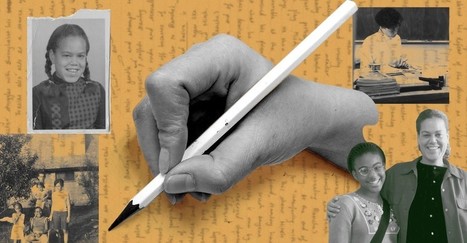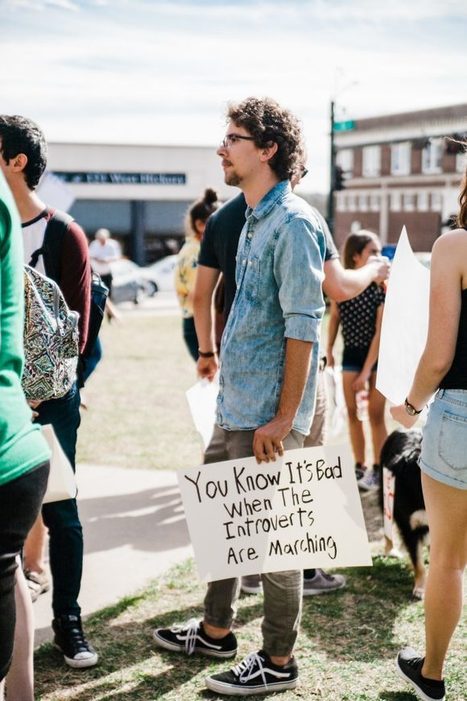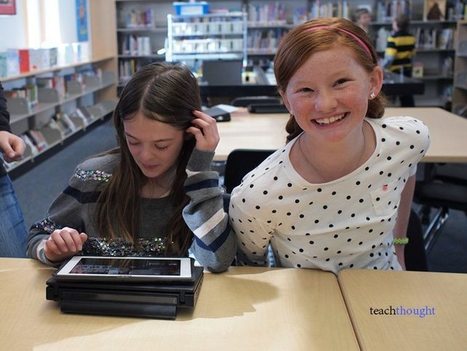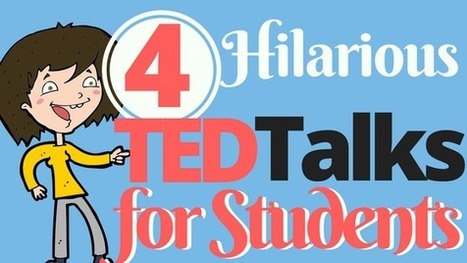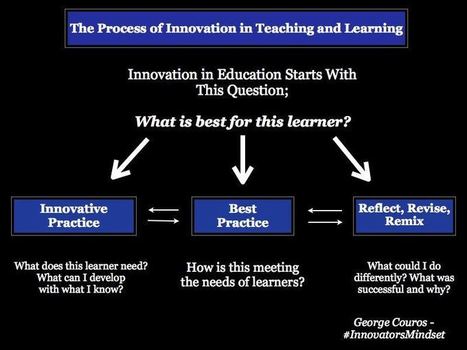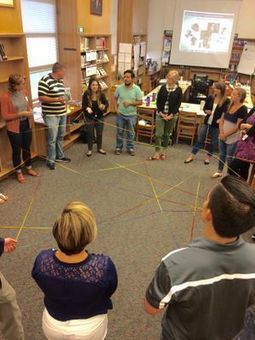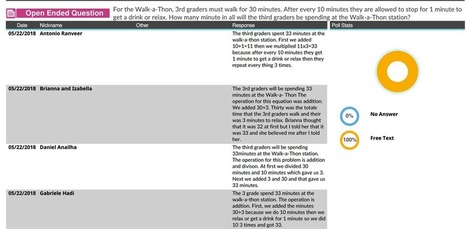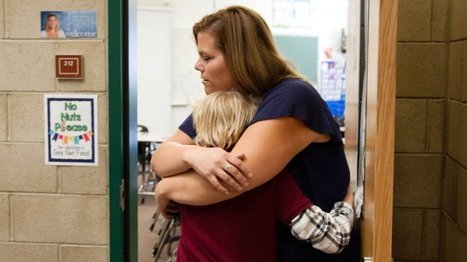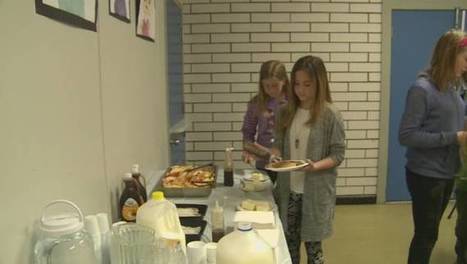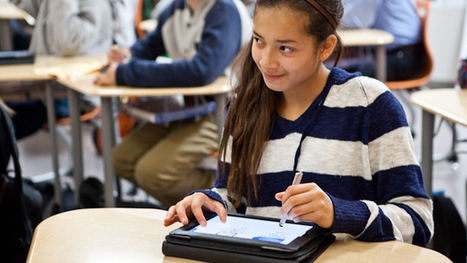 Your new post is loading...
 Your new post is loading...

|
Scooped by
John Evans
|
On New Year's Eve, back in 2012, Savannah Eason retreated into her bedroom and picked up a pair of scissors.
"I was holding them up to my palm as if to cut myself," she says. "Clearly what was happening was I needed someone to do something."
Her dad managed to wrestle the scissors from her hands, but that night it had become clear she needed help.
"It was really scary," she recalls. "I was sobbing the whole time."
Savannah was in high school at the time. She says the pressure she felt to succeed — to aim high — had left her anxious and depressed.

|
Scooped by
John Evans
|
If you always succeed in school, you’re not setting yourself up for success in life.

|
Scooped by
John Evans
|
Editor's Note: In the next five years, most of America’s most experienced teachers will retire. The Baby Boomers are leaving behind a nation of novice educators. In 1988, a teacher most commonly had 15 years of experience. Less than three decades later, that number had fallen to just five years leading a classroom. The Atlantic’s “On Teaching” project is crisscrossing the country to talk to veteran educators. This story is the second in our series. Read the first one here.
“I want to say something important about writing,” Pirette McKamey told 25 seniors in her English class at San Francisco’s Mission High School one fall afternoon in 2012. It’s incredibly hard, and always incomplete, she explained. “I’ve reread some of my essays 20 times and I still go, ‘I can’t believe I made this mistake or that mistake.’”

|
Scooped by
John Evans
|
Surprisingly, it wasn’t Deputy Headmaster Rohan Brown abruptly cutting a student’s hair that was front page news, but rather what came next.
It was a day in early March when school photos were being taken, and as the young lad walked through the front gate of Trinity Grammar, a prominent boy’s school in Melbourne, Brown noticed the length of his hair. As he had done on other occasions, he pulled a pair of scissors out of his pocket and snipped a lock of hair. Only this time, it was captured on a fellow student’s iPhone, posted on social media, and within days Brown was dismissed, after more than thirty years teaching at the school.
However, that was not the end of the story but rather the start, with several weeks of student-led protests, meetings, and online petitions to “Bring Brownie Back” which reached out to drive strong parent support. Within weeks Brown was reinstated, the Headmaster resigned together with several School Board members.
Now in light of the massive student-led protests calling for action against gun violence across America in the same month, the Brown story pales in significance. Or does it? They are just two very public examples of the influence of agency, and its impact on power and authority.

|
Scooped by
John Evans
|
Building relationships with students isn’t always simple, but it’s crucial to the well-being and academic growth of all students.
Part of the reason it’s not, in fact, ’simple’ is because every student is different and there are few universal rules for engaging students. In the same way connecting with colleagues and people in your personal life can be complicated because of different contexts, interests, personalities, and communication patterns, connecting and building relationships with students in the classroom can be equally challenging.
And a distinction should be made here between building a ‘working relationship’ and authentic relationship with students. Because of your position of authority in the classroom, a ‘working relationship’ with a students is a matter of ‘classroom management’ in pursuit of ‘student engagement.’ This approach can be efficient, but the clinical tone leaves a lot on the table for the growth of students.
If you are able to authenticate that ‘working relationship’ with genuine interest and personalization, more human and affectionate terms for that relationship can grow, resulting in the often-elusive ‘student engagement’ while also making your job—and life—easier, and your classroom a more enjoyable place for everyone to be.

|
Scooped by
John Evans
|
"Student-centered teaching is teaching designed for the student. This means that planning often begins with the student in mind as opposed to a school policy or curriculum artifact, for example. Done well, it can disarm some of the more intimidating parts of academia, while also shortening the distance between the student and understanding.
Put another way, student-centered teaching is teaching that is ‘aware’ of students and their needs above and beyond anything else. It places students at the center of the learning process.
This isn’t as simple as it sounds, especially without shifting one’s mindset towards that approach. We recently shared 32 Research-Based Instructional Strategies. The following infographic via Mia MacMeekin provides additional tools (in the form of strategies) that can help create a learning environment that can, depending on the context, more approachable, friendly, or familiar to students in your classroom."

|
Scooped by
John Evans
|
After years of testing out various talks in the classroom, I finally found a few that always go over well with my high school students. Of course, it has a lot to do with the talks being funny. Who doesn’t like to laugh? But there’s also a deeper meaning and positive message with each that resonates with the students. There is no particular order to this list. They each are awesome in their own right.

|
Scooped by
John Evans
|
As part of my school’s PBIS behavior management system, students have the opportunity to earn “tokens” they can save and redeem for rewards. A student favorite is the Stinky Feet pass, which allows students to work in the classroom with their shoes off for the day. Teachers can give students a Rocket Buck when they observe behavior that is consistent with the school expectations. As an intervention teacher, I like to be able to reward my students, but I also want the reward to be meaningful. In other words, they have to earn it! I recently figured out a way to turn the reward system into a tool for student self-reflection.

|
Scooped by
John Evans
|
Keep your high school math students engaged with these techniques.
A question that was posed recently was challenging the notion of “innovation” in education, and how it challenges best practice. “Best practice” can often be seen as the en…
Via Dean J. Fusto
|

|
Scooped by
John Evans
|
This year, NPR held its first Student Podcast Challenge — a podcast contest for students in grades 5 through 12. As we listened to the almost 6,000 entries, we smiled, laughed, and even cried. Students opened their lives to us with stories about their families, their schools and communities and their hopes for the future.
We named our winners last month — the eighth graders of Bronx Prep Middle School in New York, and the eleventh graders of Elizabethton High School in Tennessee.
But lots of other students blew us away. Here, for your listening pleasure, are just some of the many podcast entries that made us smile — and reminded us what it's like to be in middle and high school.

|
Scooped by
John Evans
|
Research is suggesting that gathering student data and building relationships must go hand in hand.

|
Scooped by
John Evans
|
"Last September I had 14 students staring at me, waiting for me to teach them how to solve a word problem. "Well, the operation is subtraction because the key word is difference," I would say. I found myself spoon-feeding 8-year-olds the answers because I was unsure of how to help this particular group of children solve difficult word problems. Seven months later, I am the one staring at my students, listening to them teach each other different ways to correctly solve the word problem. "Classroom discussion facilitator" is my new favorite title.
Not only was I doing all the talking in math at the beginning of the year, but I also found myself creating all the dialogue in English language arts. After observing my class, my supervisor guided me to "do less!" Such a simple phrase, but it really resonated with me. I realized I was doing too much talking, explaining, and assisting. How were my students supposed to take ownership of their learning if I never gave them the chance?"

|
Scooped by
John Evans
|
One economist found that platooning might be harming kids and two other economists found that looping is quite beneficial. “These studies are important because they tell us that teacher-student relationships matter"

|
Scooped by
John Evans
|
A major barrier to innovation in the classroom is teacher exhaustion. I regularly work with teachers who like the idea of trying new teaching strategies, blended learning models, and technology tools, but they don’t have the time or energy to experiment.
When I work with teachers, my goal is to get them to shift their mindsets. Instead of asking themselves, “How can I?” I want them to pause and rephrase the question, “How can students?” This shift in teacher mindset seems simple, yet it goes against most teachers’ instincts. We place a lot of pressure on ourselves to do it all. Unfortunately, that mentality robs students of opportunities to learn.

|
Scooped by
John Evans
|
When the bell rang for early dismissal on a recent afternoon at Cold Springs Middle School in Nevada, students sprinted toward the buses while teachers filed into the library, where posters filled with the names of every child in the 980-student school covered the walls.
Taking seats where they could, the teachers turned their attention to Principal Roberta Duvall, who asked her staff to go through the rosters with colored markers and make check marks under columns labeled “Name/Face,” “Something Personal,” “Personal/Family Story,” and “Academic Standing,” to note whether they knew the child just by name or something more—their grades, their family’s story, their hobbies.

|
Scooped by
John Evans
|
Breakfast is the most important meal of the day, but many people don’t realize just how important a morning meal is to a child’s ability to learn.
According to a recent survey by Kellogg Canada, the vast majority of teachers report large differences in a child’s behaviour depending on whether or not they’ve had breakfast. According to the report, 93 per cent of teachers agree that hungry children are more disruptive in class.

|
Scooped by
John Evans
|
"Imagine students working on a science project and being able to connect with an actual scientist to get answers to their questions. Imagine students studying a country and connecting with a class there to ask questions and share learning. Imagine students being able to talk with older students and their teachers about the best ways to adjust to new grade levels. Today, there are a multitude of platforms we can use to connect and engage our students globally. Here are just a few."

|
Scooped by
John Evans
|
It took me years to transform my instruction toward a more student-centered approach. This is my story where I share my journey toward student ownership.

|
Scooped by
John Evans
|
Educators have lots of ideas about how to improve education, to better reach learners and to give students the skills they’ll need in college and beyond the classroom. But often those conversations remain between adults. The real test of any idea is in the classroom, though students are rarely asked about what they think about their education.
A panel of seven students attending schools that are part of the “deeper learning” movement gave their perspective on what it means for them to learn and how educators can work to create a school culture that fosters creativity, collaboration, trust, the ability to fail, and perhaps most importantly, one in which students want to participate.
|
 Your new post is loading...
Your new post is loading...
 Your new post is loading...
Your new post is loading...









